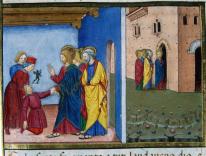The fascination of counterfactual narrative-writing that deals in alternative historical outcomes-lies in its challenge to our lazy fatalism, our tendency to believe that things ended up as they did because they had to. Such counterfactual speculations as the works of revisionist historian Niall Ferguson, or Philip Roth’s recent novel, The Plot against America, in which Charles Lindbergh defeats FDR in the 1940 presidential election, or the musings of historians of science who ponder what might have happened (and not happened) if Darwin had never set sail on the Beagle, all raise fascinating issues of contingency and inevitability, the what-ifs and might-have-beens of history.
Such inquiry makes for a fruitful way of reexamining the history of religion in general and the development of early Christianity in particular. For instance, could the Jewish movement that invented the Christian church as a new locus of identity have retained its ethnic character? Historically, that question was answered in the negative, and the New Testament that we read reflects the outcome on every page. Yet another outcome was possible and, even now, remains imaginable.
In Border Lines, Daniel Boyarin links the story of Christian identity formation during the first centuries to a richly detailed account of Jewish identity formation during the same period. Just as the emergent church could well have retained kosher dietary laws, circumcision, liturgical Hebrew, and an understanding of itself not as a new, spiritual Israel but as Israel plain and simple, so too, Boyarin argues, could a non-Christian Israel have retained-and considered authentically Jewish-a variety of beliefs about God that it ultimately ended up repudiating as Christian and therefore alien.
Boyarin invites us to imagine this different result. If salvation had been understood to come by the enlargement of the Jewish covenant, rather than by its duplication and spiritualization, all Christian males would now be circumcised shortly after birth. Certain fasts and dietary restrictions would be required of a Christian in good standing. As part of their coming of age, all Christian boys would learn Hebrew in order to take part in worship. The church, in short, would understand itself to be a greatly extended Jewish family-a tribe, if you will-standing at a certain distance from society. This distance would be a matter of pride and joy: life within the tribe would be cherished for a warmth and mutual support not otherwise to be had. The linchpin of the whole, finally, would be a rigidly enforced rule of endogamy. And lest there be temptation in that dread direction, no one would be allowed even to date a “gentile” (non-Christian), no matter how allegedly admirable his or her moral character.
Would such a church be unrecognizable as Christian? Or would it, on the contrary, rather resemble the tribalized American Catholicism of the mid-twentieth century? I applaud the reformers of Vatican II who bravely detribalized their church, eliminating the old dietary folderol, dispensing with Latin, normalizing religious dress, licensing most intermarriage, and-by integrating the church into the larger society-turning their loaf into at least the promise of leaven. But the tribalized church was never less than a church, and those who are nostalgic for it may learn from their nostalgia the plausibility of the Christian vision that lost out in the first centuries of the Common Era.
Border Lines encourages us to see historic Christianity as but one expression of a universalistic potential in Jewish monotheism. Other expressions, in language placing greater stress on “Israel according to the flesh” (1 Cor 10:18), might have developed. Rather than a new and distinct locus of identity, the church might have come to express an Israel made universal by the agency of the Messiah, whose Jewish blood we drink and whose Jewish body we eat; of whose mystical Jewish body we are all members. A Jewish church, centered on Jesus, at whose Hebrew name every knee bends that is in heaven, on earth, and under the earth-God’s only true or “begotten” son, conferring adoptive Jewish brother- and sisterhood on all mankind, making them children of his Jewish mother as well as of his divine father.
It did not happen this way, of course. Yet admitting the Jewish church as a possibility opens the eyes to what did happen. Clearly, many devout early Christians did not believe in the Incarnation, as it would later be defined at Nicaea and Chalcedon, and some of them belonged to a Jewish church with a now lost canon of Christian scriptures. Just as clearly, though, as Boyarin tells it in the most surprising chapters of his book, other Jews could and did believe in the possibility of a second divine person and even the possibility of incarnation in some form.
In making this latter claim from meticulously assembled textual evidence, Boyarin challenges learned Jewish opinion as boldly as he challenges its Christian counterpart. In a chapter subtitled, “The Prologue to John as Jewish Midrash,” he suggests that the view Rabbinic Judaism would eventually proscribe as “two powers in heaven” was once legitimately Jewish, while the view Christianity would eventually proscribe as “Judaizing” was once legitimately Christian. Neither view was originally heretical because, originally, heresy as we know it did not exist. In classical Greek philosophy, a hairesis was simply a school of thought. Before a school of thought could function as the criterion for membership in a community, a community had to arise that was in need of such a criterion. This community was the Christian Jewish community once it had undermined Jewish ethnicity as its membership criterion and identity marker by admitting gentiles.
That fateful action precipitated a double dilemma. Gentile converts in the nascent Christian church began to resist an uncongenial Jewish ethnic identity. Yet as a modified Jewish identity began to spread through the Roman Empire, non-Christian Jews faced an equal and opposite identity crisis. Though many of them may have believed that there were two (or more) powers in heaven, and though some may have believed that incarnation of one of these powers was possible, most did not believe that Jesus of Nazareth was, in fact, such an incarnation-or the messiah either, for that matter. It was as if these Jews were being outnumbered and colonized by an army whose adapted Jewish identity, while including many views and claims that they shared, included one that they did not share and would not accept.
This double dilemma, Boyarin shows, was resolved by a double repudiation. Pauline Christianity repudiated ethnic difference and embraced doctrinal difference as its criterion of membership, consolidating the church as a powerful extra-ethnic locus of identity. Meanwhile, Rabbinic Judaism repudiated doctrinal difference, after first defensively adopting it for a long while, and returned to ethnic difference-consanguinity-as its criterion of membership, guaranteeing that world Jewry would not perish by fragmentation. The banner quotation for the Christian repudiation is Paul, Gal 3:28: “There can be neither Jew nor Greek, there can be neither slave nor freeman, there can be neither male nor female-for you are all one in Christ Jesus.” The equally celebrated banner quotation for the Rabbinic repudiation is Rabbi Abba to Shmuel in the Babylonian Talmud (Eruvin 13b), resolving a long-running dispute between the House of Hillel and the House of Shammai: “These and these are the words of the living God” or, in other words, “You are both right.”
Dogma without tribe, or tribe without dogma: concretely, neither alternative is quite possible, and the history of Christianity is, unsurprisingly, a history of successive retribalizations. The history of emergent Judaism, as Boyarin tells it, is not merely a history of artful argumentation but also one of fierce conflict. Yet we must not imagine two distinct and firmly established communities espousing these contrasting principles from the beginning. Rather, we must recognize two populations, differently challenged by the same social innovation, gradually meeting the common challenge in different ways as the rabbinic and patristic canons gradually crystallized. It was their different responses to the challenge which created the difference between them, as we know it today: Judaism and Christianity each defining itself, gradually over time, by not being the other.
Border Lines is a marvelous book. The brilliant are rarely gentle, yet Boyarin-in this regard as in so many others-is an exception. He writes with “transgressive love,” to use his own phrase, but always with perfect courtesy, combining the most intense textual attention with respect for the least participant in the discussion. An articulate critic of Likud who is, in addition, the author of Unheroic Conduct: The Rise of Heterosexuality and the Invention of Jewish Man (University of California Press), Boyarin surely cannot be entirely surprised if, when he speaks of his fondness for Christianity in the language of “coming out,” Jewish scholars maintain a strained silence. As for Christian scholars, rather than respond in kind to his generosity as well as his challenge, they seem to have excused themselves from reading a work that descends so deep into the difficulty of rabbinic argumentation.
Whatever the explanation, the awkward fact remains that this major work-by the chairman of the Department of Near Eastern Studies at the University of California, Berkeley-receives here its first review. I regard the silence of those better qualified than I to engage this work as deeply regrettable but almost surely temporary. “Jews and Christians,” Boyarin writes, “are called upon at this moment to learn from our own difficult histories, without in any way rendering those histories equivalent phenomenologically or morally, and do something different now.” In a fruitful career not yet nearly over, Border Lines, the culmination of many years of work, may well remain Daniel Boyarin’s masterpiece.


